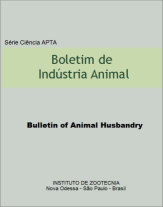Influence of technical training on human-animal interactions at milking
Keywords:
interaction, dairy cattle, workerAbstract
Faced with the prominent developments in breeding dairy cattle systems in Brazil, it is observed that the aspects related to animal welfare (AW) and the human-animal relationship did not achieve the same breakthrough. Thus, actions are needed that may generate positive changes in human-animal relationship, which relates closely to the AW and productivity in dairy cows. Therefore, this work aimed to evaluate the human-animal interactions at milking and the influence of technical training on these interactions. The research was divided into four stages. The first step consisted in selecting of six dairy farms based on pasture in São Paulo State. The second step was the evaluation of milking and the action of workers through the proposed protocol by Hemsworth et al. (2002): moving the cows in the shed for milking line activities; forcing the cows in the milking position; coupling and uncoupling the liners and moving the cows out of the milking line. Tactile interactions of humans toward the cows were classified as positive (POS) or negative (NEG), which were considered positive interactions "patting", affection or support hand on the back, legs or flanks of the cow, whereas negative interactions included slaps , shoving, or blows with the hand or with objects of any type. In the third stage, it was realized the technical training on good practices for the AW with the workers of the respective farms and finally, a new evaluation of the interactions was performed in the fourth and final step. At the end of the four stages, comparing the levels and occurrences of initial and final interactions obtained after the training, it was possible to notice a reduction of negative interactions at milking. Furthermore, it was possible to visualize what properties where milking is conducted by hired workers, the number of negative interactions is greater, and that in properties where milking is performed by the owner himself the number of positive interactions was higher. Therefore, it is suggested that the technical training of workers on rational management and raising of dairy cows helps these people understand the animals' behavior and thus there may be better interactions between them and provide better working conditions within dairy farms.Downloads
Downloads
Published
Issue
Section
License
Os autores não serão remunerados pela publicação de trabalhos, pois devem abrir mão de seus direitos autorais em favor deste periódico. Por outro lado, os autores ficam autorizados a publicar seus artigos, simultaneamente, em repositórios da instituição de sua origem, desde que citada a fonte da publicação original seja Boletim de Indústria Animal. A revista se reserva o direito de efetuar, nos originais, alterações de ordem normativa, ortográfica e gramatical, com vistas a manter o padrão culto da língua e a credibilidade do veículo. Respeitará, no entanto, o estilo de escrever dos autores. Alterações, correções ou sugestões de ordem conceitual serão encaminhadas aos autores, quando necessário. Nesses casos, os artigos, depois de adequados, deverão ser submetidos a nova apreciação. As opiniões emitidas pelos autores dos artigos são de sua exclusiva responsabilidade. Todo o conteúdo deste periódico, exceto onde está identificado, está licenciado sob a Licença Creative Commons Attribution (CC-BY-NC). A condição BY implica que os licenciados podem copiar, distribuir, exibir e executar a obra e fazer trabalhos derivados com base em que só se dão o autor ou licenciante os créditos na forma especificada por estes. A cláusula NC significa que os licenciados podem copiar, distribuir, exibir e executar a obra e fazer trabalhos derivados com base apenas para fins não comerciais.













